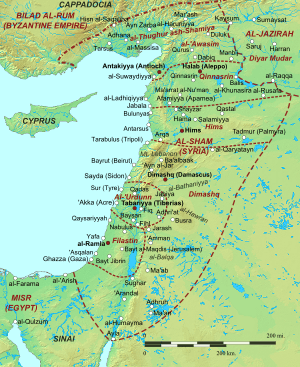Alptakin
Alptakin (also known as Haftakin and Aftakin) was a Turkish military officer of the Buyids, and later the ruler of Damascus.
Early life and rebellion against the Buyids
He was a freedman of the Buyid ruler of Iraq, Izz al-Dawla Bakhtiyar.[1] Nothing further is known about him until in 973, when he joined the rebellion of the Turkish officer Sebük-Tegin, who managed to occupy Baghdad and many other parts of Iraq. The Turkish rebels under Sebük-Tegin then besieged Wasit, where Izz al-Dawla had fortified himself. Sebük-Tegin died during the siege, and Alptakin was shortly chosen as the new leader of the Turks. Meanwhile, a Buyid army under Izz al-Dawla's cousin Adud al-Dawla was marching towards Iraq, and by 975 managed to completely defeat the rebels at the Diyala River.[2]
Invasion of Syria and war with the Fatimids

After his defeat at the hands of the Buyids, along with ca. 300 of his followers,[3] Alptakin fled to Syria, where they managed to capture Hims.[1] Alptakin then allied himself with the Qarmatians, and in the winter of 975 invaded the Mediterranean coast and laid siege to Fatimid city of Sidon. He shortly managed to capture the city, resulting in the massacre of 4,000 Fatimid troops.[1] He then captured Tiberias, and marched towards to Damascus, which he took without much resistance. The Fatimid Caliph al-Aziz Billah then sent an army under his general Jawhar, who managed to reconquer the Mediterranean coast and reach as far as Damascus, which he besieged.[4]
Alptakin's Qarmatian allies soon arrived, and managed to force the Fatimids to lift the siege. The Fatimid army then fled to Ramla, but quickly abandoned it, leaving the city open to a Qarmatian invasion.[5] The combined army of Alptakin and the Qarmatians then besieged Ascalon, where the Fatimid army had fled to. After a long siege which lasted over a year, the Fatimids agreed to make a peace treaty: Alptakin would receive Palestine, while the northern border of the Fatimid domain was set at Gaza.[5][6] To make the treaty more palatable to the Fatimids, Alptakin agreed to recognize the Fatimid Caliph as his suzerain.[6]
In 978, Izz al-Dawla, whose territories had been conquered by Adud al-Dawla, fled along with his two brothers and other Dailamite followers to Damascus, where they were warmly received by Alptakin, who incorporated the Dailamites into his army.[7] Meanwhile, a new Fatimid army under al-Aziz himself was marching towards Damascus, and a battle ensued between the Turks and the Fatimids near Ramla; Alptakin charged the left wing of the Fatimids, killing many. However, the Fatimids turned the tide of the battle by making a counter-attack on the centre and right wing of Alptakin's army, killing ca. 20,000 of his men.[8]
Alptakin managed to flee from the battlefield to the desert, where he almost died of thirst, but was found by the leader of the Tayy tribe and an old friend of his, Mufarrij ibn Daghfal ibn al-Jarrah. Alptakin was brought to the latter's home, where he was treated with honour. During his stay the latter's home, however, Mufarrij betrayed him and gave him to al-Aziz in exchange for 100,000 gold dinars.[9][8]
Alptakin was then taken to the Fatimid capital of Cairo, where he was honourably treated by al-Aziz, who incorporated Alptakin along with his Turkish followers into the Fatimid army. However, Alptakin was later poisoned by al-Aziz's vizier, Yaqub ibn Killis.[10]
References
Sources
- Canard, Marius (1991) [1965]. "D̲j̲arrāḥids". In Lewis, B.; Pellat, Ch.; Schacht, J. The Encyclopedia of Islam, New Edition, Volume II: C–G. Leiden and New York: BRILL. pp. 482–485. ISBN 90-04-07026-5.
- Gil, Moshe (1997). A History of Palestine, 634–1099. Cambridge: Cambridge University Press. ISBN 0-521-59984-9.
- Kennedy, Hugh N. (2004). The Prophet and the Age of the Caliphates: The Islamic Near East from the 6th to the 11th Century (Second ed.). Harlow, UK: Pearson Education Ltd. ISBN 0-582-40525-4.